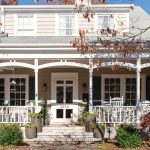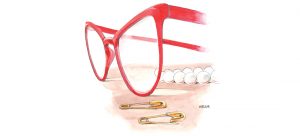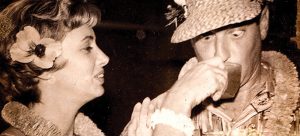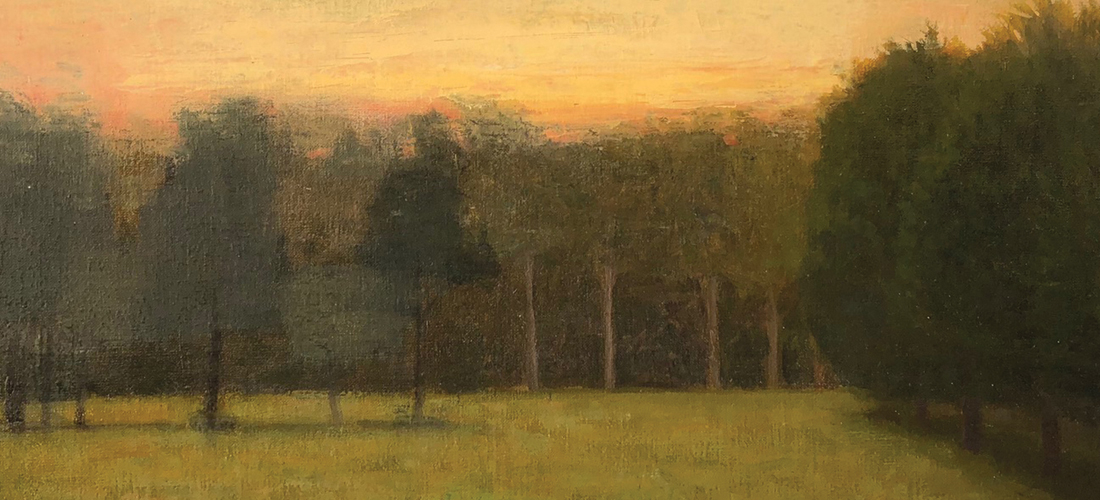
Lightcatcher
For landscape painter John Beerman, beauty is everywhere
By Nancy Oakley
A sweeping lawn on a sunny day glistens in shades of greens and yellows, then blues and grays where trees have cast their shadows. You can fairly catch the scent of freshly cut grass, feel a faint breeze skip across your brow. Just as you might absently mop your brow from the scorching heat of a late summer day, while gazing at a dry and dusty country road that curves endlessly toward the unknown. Never mind that the scenes before you are of North Carolina and Texas, respectively. Or that you might never have visited either one of them. “It doesn’t have to be the actual place,” says John Beerman, painter of the two landscapes. He smiles, recalling traveling down a similar dirt road in the flatbed of a pickup truck, with his paints and easel in hand. “It’s not so much about the image as how it’s put together,” he says. And, of course, how the image makes the viewer feel. At some point, we’ve all experienced the elation of being alive on a sunny summer day, or weariness from its oppressive heat.
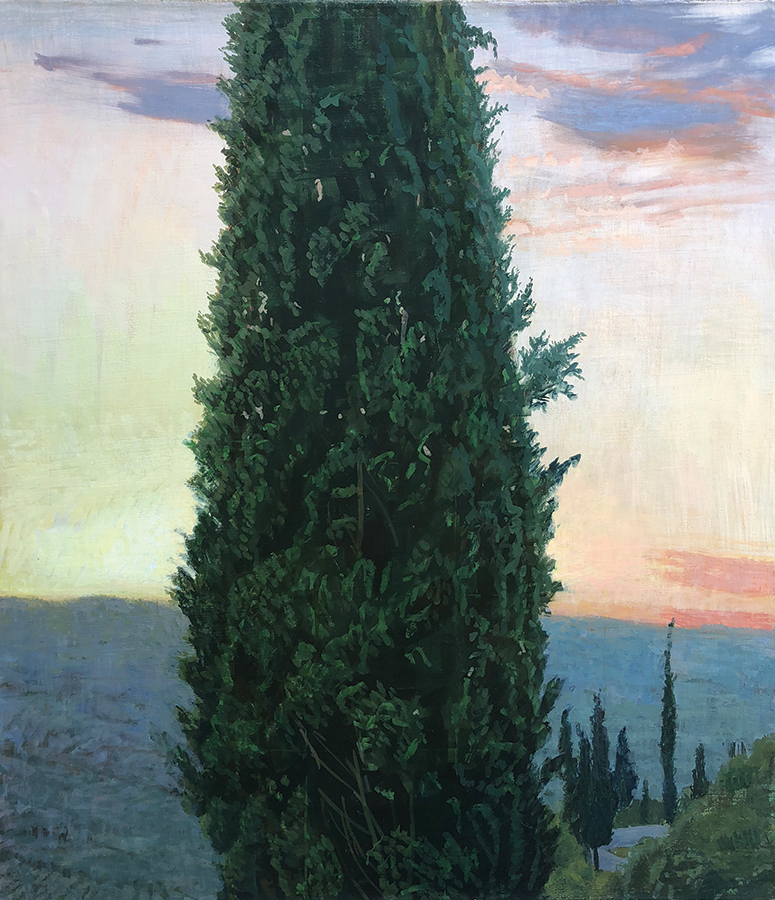
Eliciting such emotional responses hinges on the play of light in nature, a fascination for the artist and Greensboro native, who stands before the canvas of the summery lawn in his Hillsborough home that he shares with poet Tori Reynolds. “When you look at grass, it has all these things going on. At first you think it’s just a green stripe or a yellow stripe. There’s all this richness.” But capturing that richness in a painting is not about “flash” or a “horn blast,” Beerman insists. “Rich color is not the most brilliant blue you can get out of a tube.” Rather, it’s a matter of, “How do you enrich a gray to make it a full gray? How do you make these subtle nuances glow?”
In another painting of a cottage in New Mexico lit from within at dusk, Beerman has carefully applied several shades of blue, blue-gray, violet and aqua to replicate the building’s corrugated metal roof. He points out the telephone pole and wire in the scene, a feature he once included in a series of paintings of churches. “I’ve had several people come up to me and ask: ‘Why did you mess it up with the telephone wires?’” he laughs. “I just think it’s kind of fascinating the way it curves.” He was similarly taken with, of all things, a Rhode Island trailer park. “The light as it’s falling on the dreary old trailer in a certain way, that speaks to me as much as a beautiful mountainside,” Beerman says. “I’m not really concerned with the ‘beautiful.’ Anything can be beautiful.”
He couldn’t help but be struck by the beauty of the North Carolina mountains during his childhood. It was then that his artistic journey began. His mother had always encouraged art as a pursuit, buying her youngest son chalks and pastels, and enrolling him in private lessons. “I was taking art classes before first and second grade,” he recalls of the sessions with a family friend, Barbara Covington. “She lived on Princess Anne and taught out of the back of her house.” Beerman reels off other memories of the Gate City from those early years: Fisher Park and attending Irving Park elementary school. “I remember the old Lawndale Shopping Center. I’d go to the GI 1200, down from Roses. It was called GI 1200, because it was Government Issue. They had Army knapsacks and such.”
But it was those visits in the early 1960s to his grandparents’ cottage in the mountains that left an indelible impression. In those days, Beerman says the place had no TV, and with few children his own age in the area, he had a lot of time on his hands. He spent it in the company of a distant relation whom Beerman describes as “an amateur kind of a Sunday painter.” The young child was mesmerized. “I’d watch him paint on the deck overlooking this beautiful lake. I think watching him showed me: How do you make use of your time? Nobody wants to sit around. I like to do something. It seemed like a pleasant thing to do. It got me going.” He pauses for a moment, “Plus it was in this beautiful setting . . . maybe that’s what sent me to Vermont.”
The Green Mountain state is a long way from Greensboro, but it beckoned the budding artist as he was starting 10th grade at Page High School. Six weeks into the fall semester, he was working on an assignment in an art class. “At that time it was [called] commercial art,” Beerman remembers. “The first assignment was to go through a stack of magazines and make an ad for GM,” he laughs. But it was an advertisement of a different sort that would transform his life as he dutifully went through the periodicals, choosing one titled New York Times Magazine. “I’d never heard of it, at that point in my life,” says Beerman (ironically, now a loyal subscriber to the Times). “I started to cut stuff up in it, and I noticed in the back, they used to have these little ads for schools,” he continues. One of them, for Woodstock Country School, on a 300-acre farm in Vermont, caught his eye. As did its small size — only 60 people in the student body — and the curriculum. “That little ad said, ‘stresses the arts and humanities,’” Beerman recalls. “And that’s what really stood out to me. I’m not much of a science guy.” The school’s fall term started in early October, so Beerman figured there was still time to enroll; with money set aside from his grandparents, he could cover the cost of tuition.
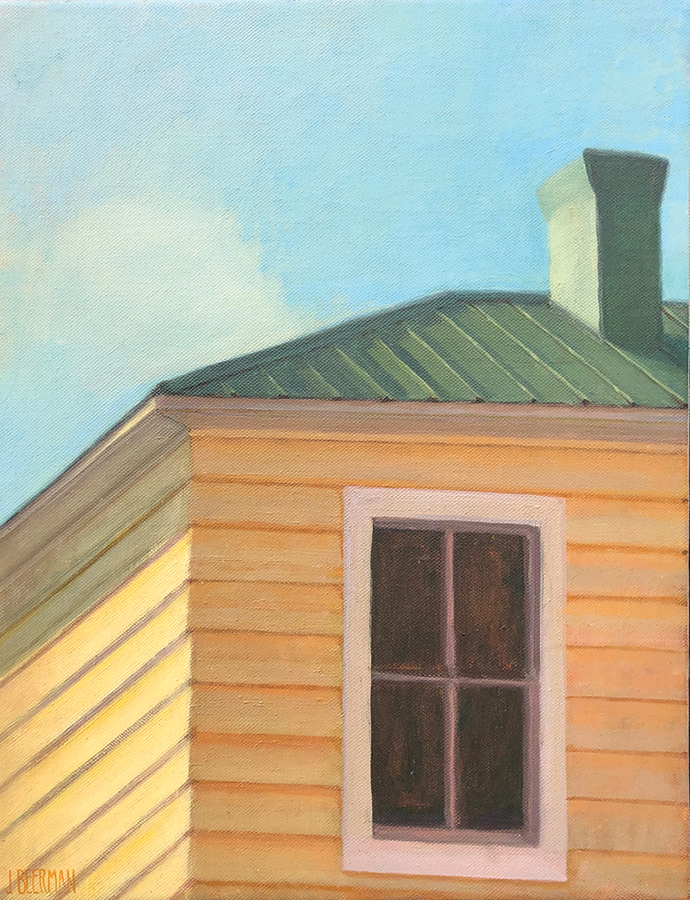
He was ready to embrace change. His parents had divorced years earlier, his older siblings had all left home for college, and Greensboro in the mid-1970s held little appeal for the 15-year-old. “Downtown was dead; the big thing was Four Seasons Mall; that’s where everybody went. And for whatever reason, I never felt a part of that scene,” Beerman says. “There was not much to keep me around.”
So, he packed his bags and headed north, and for the next three years, he blossomed. “There were kids from all over the place, from out in the country. It was beautiful, Vermont.” Though not particularly outdoorsy, Beerman says he has always loved being outside. “I felt solace in nature,” he reflects. “It’s ever-changing, it kind of feeds my soul . . . and I love light.” Particularly how it changes. He had ready inspiration in his rural surroundings, where he continued drawing and became involved with photography. So much so, that when it came time to apply to art school — in Beerman’s case, the prestigious Rhode Island School of Design (RISD) — he submitted a portfolio in photography and film.
But once again, his trajectory took a detour. “My first figure drawing class at RISD was just charcoal and newsprint. I loved the immediacy of it. I loved — I guess it was the hand quality,” Beerman says. In addition to requiring long, solitary hours in a darkroom, photography, he emphasizes, was “not a hand-to-hand tactile thing, and I loved the tactile thing.”
Beerman quickly changed his major to painting, which provided him with the opportunity of “actually building something. You’re making something with your hands, and I like that. I liked it a lot. Still, to this day, I try all these different papers and linens and supports,” he says. In another landscape, featured in a recent exhibit at Anne Neilson Fine Art in Charlotte, olive and cypress trees on a Tuscan hillside glow in tones of green, yellow and silver, and appear to sway. “This is an egg tempera painting,” Beerman explains, adding that the simple mixture of egg yolk and pigment produces a translucent effect. “It adds a complexity to the color,” he says — as opposed to some of his oil paintings that create what he calls a “mushy” effect.
Beerman discovered egg tempera during his training at RISD. “Craft,” he says, “was really important to me.” At a time when Abstract Expressionism was de rigueur, he felt he had to explore other avenues to inform his painting. “I had to go into the illustration department and take egg tempera classes,” he recalls, “because in painting it’s really frowned on; craft was academic.”
He likes the medium because it dries quickly once it’s applied to a surface primed with gesso [pronounced “Jess-OH”] that he makes himself, with rabbit skin glue and calcium carbonate. “Same thing they used back in the old days before oils came in,” Beerman says of the Italian Renaissance painters. And indeed, another of his Tuscan landscapes is reminiscent of the stylized backgrounds one might see in Piero della Francesca painting. Or perhaps 17th-century French master Nicolas Poussin. “I’ve been all over the place,” Beerman allows. “I had evolved through influences, from Modern to Ancient, and somehow it filtered through me. It’s kind of a mystery because you don’t know it till you see it.”
He saw it clearly in the East Hampton Library while he was living in an artists’ enclave of Springs, on the south fork of New York’s Long Island, following his tenure at RISD and Maine’s Skowhegan School of Painting & Sculpture. “I discovered the Luminist School, which I’d never known about, had a lot of influence on me.”
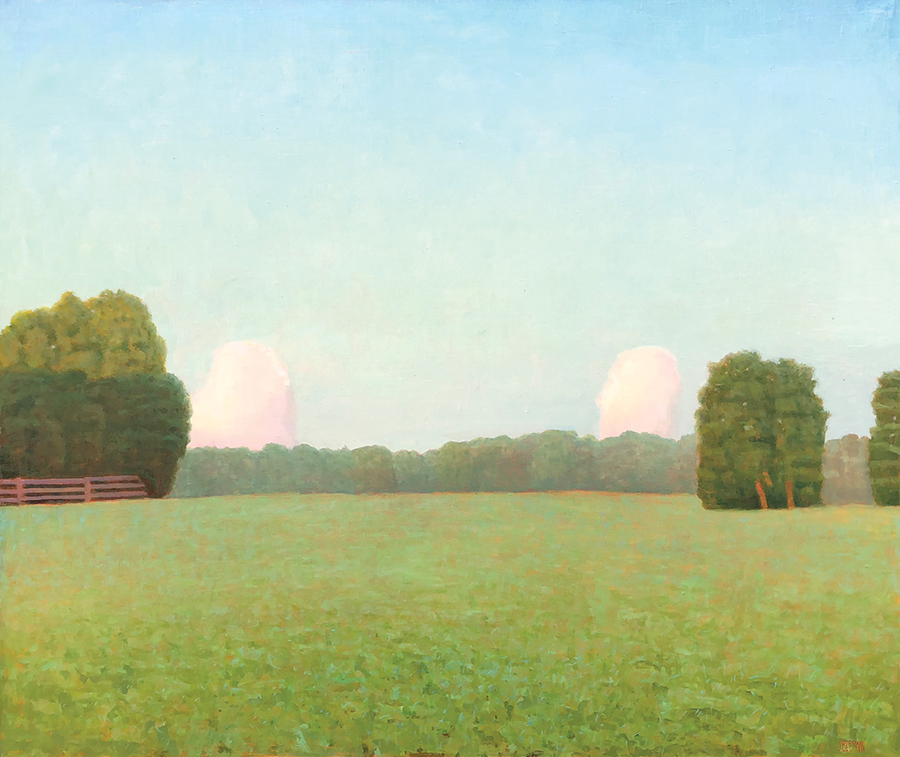
Considered among art historians an offshoot of the Hudson River School, the Luminists came later, in the mid-19th century, directing their attention to the effects of light on landscapes. Unlike the Impressionists, who followed a similar quest with diffuse brushstrokes, the Luminists tended toward more precise renderings, their works more muted and reflective. Or as Beerman observes, “The Hudson River School was more dramatic — drama with a big ‘D’ — whereas the Luminists were not melodramatic.” Their subdued paintings, particularly those of Fitz Hugh Lane and John F. Kensett resonated with him. “That’s when I really got married to the landscape,” he says.
Borrowing his father’s VW camper, he retraced Fitz Hugh Lane’s travels through Maine and produced works for his first show in Manhattan — at a time when landscape painting was not in vogue among the intelligentsia. “It was not considered cutting-edge,” Beerman acknowledges. “I don’t like it when art becomes like an echo chamber of a very small group of people. I don’t want art cut off from most people.”
Just as he forged his own path in his youth, leaving Greensboro for Vermont, or exploring those illustration techniques at RISD, Beerman made his singular mark on the art world, his works ultimately finding places in the permanent collections of New York’s Metropolitan Museum of Art, the Whitney, the Museum of Fine Arts, Houston, and the North Carolina Museum of Art in Raleigh.
Based in Nyack in the Empire State’s Hudson River Valley, he relished being only 30 minutes from Gotham’s museums. “Frederic Church did oil sketches when he was traveling. I got to go to Cooper-Hewitt and pick them up — put white gloves on my hand and look at these paintings,” Beerman remembers. “I was like, ‘Oh my God!’ It was great!” He maintained close ties with his professors at RISD, where he also taught, and painted his environs, such as a large horizontal of the Hudson River, its imposing cliffs rendered in shades of violet and dwarfing the town of Yonkers in the distance. “Yonkers is an industrial town, factories and all that stuff,” Beerman explains. “And right across are the Palisades — basically the same thing Henry Hudson saw 400 years ago, which is really cool.”
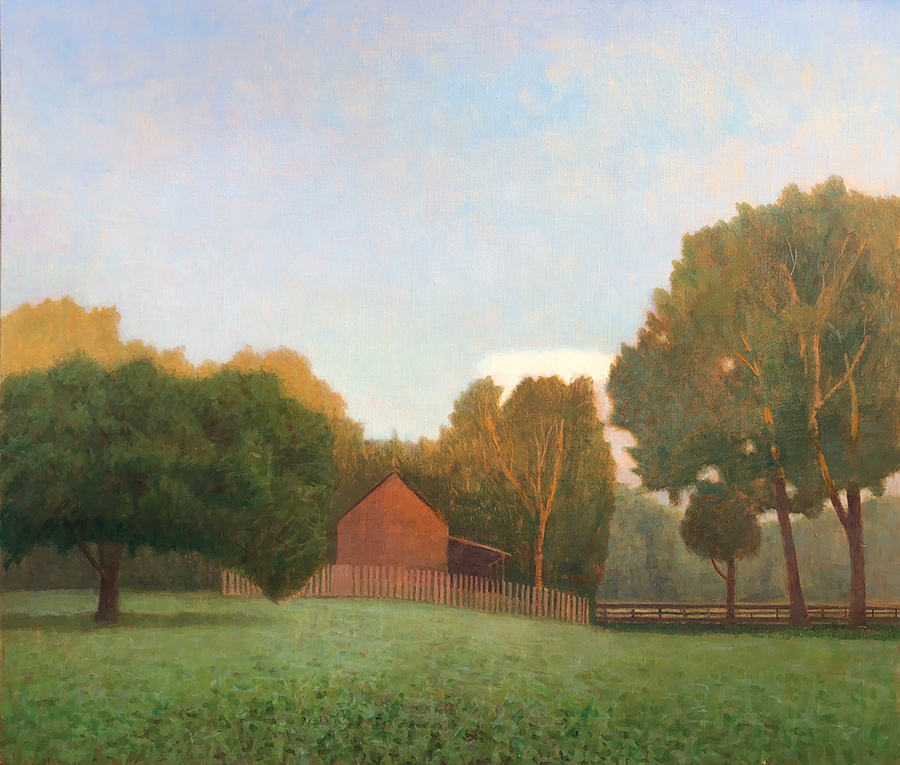
The painting hangs in the hallway of Beerman’s home in Hillsborough. He had heard about the small burg after returning to North Carolina in 2009 when his marriage ended and rented a place there. It was a challenging period, but Beerman reconnected with his roots. His brother Bob, who with his wife, Teresa had established the Bass Violin Shop near downtown, and as Beerman concedes, “The silver lining was, my father was in Well-Spring [retirement community] and dying, and I got to spend the last three months with him.”
There have been other silver linings, as well. After his 40-odd-year absence, North Carolina proved a revelation to the artist. “It’s a wonderful place!” he says enthusiastically. In the 10 years since his return, he’s rediscovered his old hometown, serving on the board at GreenHill for a time, and getting to know a revived downtown with new places, such as Scuppernong Books, which has become a favorite, along with the Greensboro History Museum and, as one would expect, Weatherspoon. Most important: “We’re surrounded by this beautiful landscape.”
A landscape that has been a prolific muse. A frequent subject is Chatwood, the Hillsborough estate of friend and writer Frances Mayes, and where Beerman painted that large expanse of grass in summer. (Mayes also lent him the use of her property in Cortona, Italy, where he painted the Tuscan landscapes.) Beerman likes to revisit the same locations on Chatwood’s grounds season after season: the barn in summer, snow-covered in winter; a pasture bristling with greens in one panel or in somber gray and brown hues of a November day in another. He’ll often make oil sketches, or notes or drawings in a sketchbook and then refine them in the larger paintings in his studio, sometimes working on multiple paintings at different times throughout a given year. Until such time as a proper studio is completed in his house, he uses his garage, where among several neatly labeled crates full of paints, brushes, rags and other materials, he produces a small sketchbook. Its pages contain blocks of color and drawings of trees, studies for a larger painting, commissioned by Rex Hospital in Raleigh.
The artist has also conducted painting workshops at Chatwood, and in other locations around Hillsborough, as one former student recalls. Greensboro painter and interior designer Bill Crowder says he learned to “look at things and see things better” under Beerman’s tutelage. “How blue wasn’t just blue, but many colors,” Crowder explains. “The main thing I learned: How things aren’t what they seem necessarily, and seeing what we don’t perceive as being there.” Beerman uses the example of the tufted titmouse to make the same point. “It’s the most gorgeous bird. It’s just subtle grays, that’s all it is. Most beautiful color ever. But you’d be hard-pressed to say, ‘What color is it?’ That’s what’s so fascinating to me about color.”
He’s constantly experimented with color in a number of projects since his return home: still lifes of Jugtown pottery, the shadows of a clapboard yellow house next to his old studio in downtown Durham, studies of Reynolds, one of the few figure paintings he’s done. The two have collaborated on a poetry project, a volume of broadside verse, one of which Beerman illustrated with a brilliant red Tuscan poppy that seems suspended in time. Another depicts a shaded garden where, in a touch of whimsy, a black cat is stretched out on a patch of grass. “My dealer in New York said, ‘Love the painting, but can’t do the cat.’ That’s the problem with New York,” Beerman says, shaking his head. “Why do you have these rules and stuff? Cats are like, soft and cuddly and not cutting-edge, I guess. But, no way I’m getting rid of that cat!”
And, of course, Beerman revisited the place where it all began, the mountains. There, for an entire month, he created “a whole mess of paintings from one spot” — the porch of a house that a collector had made available to him. The experience proved challenging. “I’d get it just right, go away. And then that moment would not just come back the next day, or the next day. That’s the trick, as a landscape painter: It’s never the same twice, and how do you work on a painting for a long time and somehow keep focus for that moment you originally set out to do?” Beerman posits. One solution is to go the mythic route, as in Mountain, New Moon, a standout in the recent exhibit at Charlotte’s Anne Neilson gallery. In it, an oversized orb dominates a shadowy peak of the Blue Ridge. “I sometimes fool with nature,” says Beerman. “The moon was not that big, but I felt I should go ahead and make it that big. It’s not always literal.”
It’s a testament to a master in full command of his art, this North Carolina native son with the light of his native sun — and moon — at his fingertips . . . that shines from within. OH
Nancy Oakley is the former senior editor of O.Henry.


